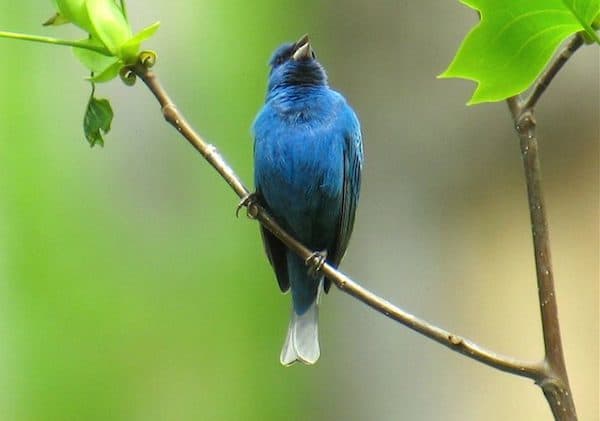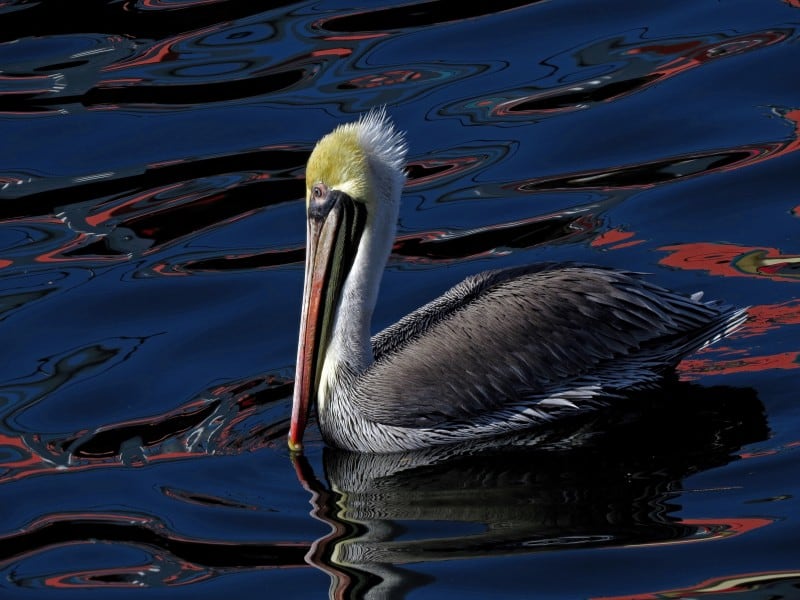Summer Birds of Illinois (June, July, August)
While the excitement of spring migration has passed, summer holds a more subtle form of wonder. The birds stay in one place now, raising a family and giving you a chance to hear them sing and observe them feed their young.
By June the familiar backyard birds such as northern cardinal, black-capped chickadee, and downy woodpecker are feeding young and if you have bird feeders or bird houses you may get to watch the youngsters begging for tasty morsels from their parents. House wrens will use nest boxes, and you can hear them singing their warbling melodies all summer long in your backyard . When the young have hatched, you can enjoy watching the adults gathering tasty morsels all day long, maybe even one day get a glimpse of the young taking their first flight out of the box.
A visit to one of the state’s many preserves and refuges can bring you close to other breeding birds, which require more specific kinds of habitats in which to raise their young.
In southern Illinois, you’ll hear prothonotary warblers seemingly everywhere in the swamps, along with less-frequent cries of the red-shouldered hawk. At Trail of the Tears State Forest, worm-eating warblers nest on steep, leaf-covered slopes. The male often sits high atop a tree giving his high-pitched, rapid trill to lure possible intruders away from the female who is sitting tightly and quietly on the nest. Kentucky warblers breed on or close to the ground, hidden in low understory at the park and at other places in southern Illinois. They give a loud, melodic, churry, churry, churry song.
Giant City State Park is a great place to enjoy the breeding birds of southern Illinois including summer tanager in the woodlands, orchard orioles in the shrubby areas and 12 species of warblers including northern parula and yellow-throated warbler, in tall trees such as sycamores. At night, listen for the whip-poor-will call its name repeatedly. The chuck-will’s-widow is another southern Illinois breeding specialty, and the best place to hear it call, beginning at dusk and through the night, is along the road at Lake Murphysboro State Park.
Drive around some of the shrub-laden roads of the Shawnee National Forest and you may find another southern Illinois specialty, the blue grosbeak. Indigo buntings seem to be ubiquitous in southern Illinois; they like shrubby areas for breeding and are often perched atop a tree singing their bouncing two-part song. Dickcissels commonly breed in agricultural fields where there are tall stands of wildflowers or weeds.
Mississippi kites are breeding in June, too, and can be found only in extreme southern Illinois as well as a few spots father north and west along the large river valleys. Southern Illinois is also the land of the barred owl; this fascinating species gives a most unusual courtship song. Who cooks for you, who cooks for you all? the male calls. The female responds in kind, but with a slightly higher pitch, and soon the two are dueting in a raucous fashion to reinforce their bonds.
In woodlands throughout the state eastern wood-pewees sing their names, while great crested flycatchers issue wheep from deep woods and woodland edges. Both nest high in trees, while wood thrushes choose lower shrubs within woodlands in which to build their nests.
Also in wetlands throughout the state are breeding herons and egrets. By June in southern Illinois, they are feeding their young and some young may even be ready to fledge. Lake Renwick Heron Rookery and Nature Preserve near Joliet, in northern Illinois, hold an impressive number of breeding great blue herons, double-crested cormorants, and great egrets. These birds build stick nests in trees, but conservationists have helped them by erecting platforms atop trees in which these birds build their nests. In June, you can see hundreds and hundreds of these large waders sitting on nests, flying to and fro to add sticks to their nests and feeding squawky, noisy young.
Purple martins breed statewide, too. This large swallow once bred in natural cavities, but competition from starlings and lack of habitat have required humans to intervene. Today, purple martins only breed in human-supplied houses in Illinois. Griggsville, a small west-central town calls itself the purple martin capital of the nation. Some 600 purple martin high-rises attract the birds and visitors each summer.
Eastern bluebirds also are raising young mostly in nest boxes; you’ll find this species statewide near boxes erected in appropriate places: open, low grassy areas for feeding adjacent to trees with perches for males to sing. The North American Bluebird Society has information on how you can start your own bluebird trail. Visit the Resources section of this book for more information.
Illinois grasslands are alive with bird song and activity in June and early July. Eastern meadowlarks can be found in most any size of grassland statewide, but some other species require more specific habitat. The bobolink likes medium-height grasses and will also nest in hayfields, while the grasshopper sparrow likes short, dry grasslands and the Henslow’s sparrow prefers wetter grassy areas. Find a large grassland complex with all those components and you’ll find all these species. Midewin National Tallgrass Prairie features these breeding grassland birds as well as the state-endangered upland sandpiper and loggerhead shrike. Many of the state’s grasslands are gone, replaced by agriculture and development. That’s why it’s essential to protect places like Midewin to provide habitat for grassland breeders.
Wetlands have also been drained and besides the huge acreage of swamplands in southern Illinois, the only remaining high-quality wetlands left in the state are mostly in the northeast. Here’s where you’ll find the breeding yellow-headed blackbird, as well as black terns, pied-billed grebes, king rails, and other secretive wetland species. The yellow-headed blackbird is a state-endangered bird that breeds only in high-quality wetlands mostly in northeastern Illinois. It can be found at Black Tern Marsh at the McHenry Dam portion of Moraine Hills State Park where it gives its raucous, rusty-hinge like song. Roughly 20 to 25 pairs of sandhill cranes now breed in various northeastern and northwestern Illinois wetlands including the Chain O’ Lakes State Park The species was once a more common breeder in the state.
Migration is already beginning in July—at least for shorebirds, which are heading south from their northern breeding grounds. In early-to-middle-July, greater and lesser yellowlegs are coming through, followed by the semipalmated and least sandpipers—many recently hatched young shorebirds are flying through Illinois in July and August taking their first long migratory journey. They come through northern Illinois first, flying south and stopping to rest and feed along the way.
By mid-August, it’s plain for birders to see that breeding season is closing and migration is once again upon us. Some of the first migrating warblers appear in northern Illinois, our yellow warblers have already left, and fall is in the air.




